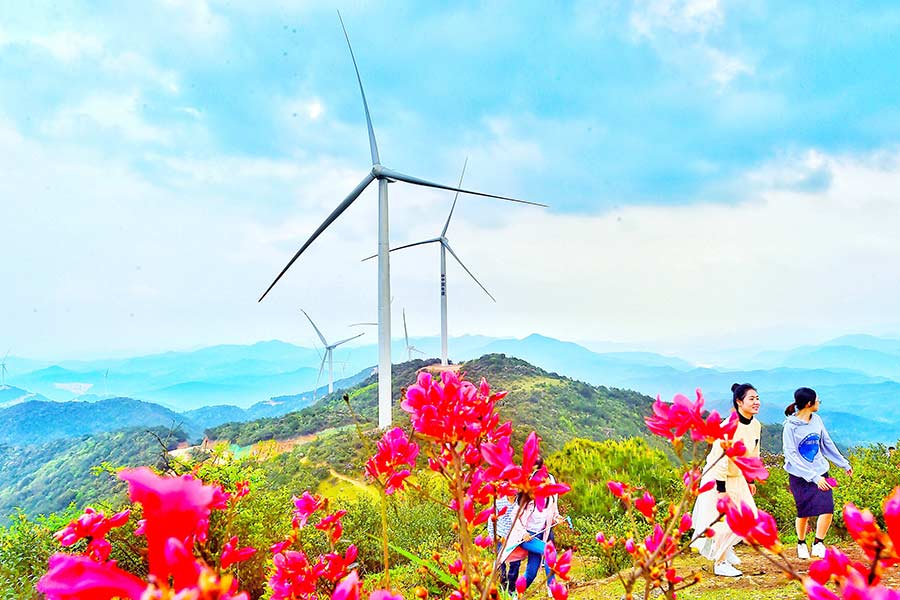Wind, solar photovoltaic power gaining momentum


Renewables to help create low-carbon and clean, safe energy mix, say experts
Wind and solar photovoltaic power are likely to achieve grid price parity within 2020, while at the same time, their quick development will further diminish the share of hydropower in the total power output by renewables in China, according to industry experts.
Zheng Sheng'an, president of China Renewable Energy Engineering Institute, estimated the rapid growth of wind and solar power will continue throughout 2025, driven by the country's commitment to reducing carbon emissions even as conventional hydropower is slowing down due to restraining factors such as increased costs and environmental protection.
Installed capacity of renewable energy in China totaled 728.96 gigawatts by the end of 2018, which accounted for 38.4 percent of the total installed capacity, and increased 11.7 percent year-on-year, while the year-on-year growth of installed power capacity was 6.7 percent in 2018, according to the China Renewable Energy Development Report 2018, released by the CREEI last week.
Newly installed renewable capacity in 2018 was 76.44 GW, taking up 63.8 percent of the newly installed energy capacity. Renewable electricity output in 2018 was 1,867 terawatt-hours, increasing 10.1 percent from 2017.
The report estimated that renewables in China will continue to see rapid growth, and in 2020, the installed conventional hydropower connected to the grid will be 340 GW, while that for wind power and solar power will be 230 GW and 250 GW.
Currently, among all the major renewables, which also include biomass and geothermal energies, development of wind and solar energies reported the most remarkable progress.
About 85 percent of newly installed renewable capacity in 2018 was for wind and solar energy.
The output of wind and solar power contributed 34 percent to the total renewables output in 2018, almost triple that in 2011(13 percent), while hydropower's contribution to total renewable power output decreased to 66 percent in 2018 from 87 percent in 2011.
"It seems the development of conventional hydropower lags behind the goals set by the 13th Five-Year Plan (2016-20), due to declining profitability and increased environmental protection requirements," Zheng said.
Most of the hydropower to be developed is now located in western regions or the upper reaches of rivers, where smaller water flow and lack of infrastructure and consumption demand bring about difficulties and challenges to develop hydropower, he said.
At the same time, due to technological improvements and enhanced operation, cost of wind and solar power is continuously dropping, increasing wind and solar power's competitiveness against coal-fired power, he said.
The national average for the cost of onshore wind power was about 7,000 yuan ($1,023) per kilowatts last year, while in some places the figure was even below 6,000 yuan. In addition, offshore wind power develops quickly with emerging new technologies, said Zheng.
He cited the example of Ningxia Hui autonomous region, where the capacity of 20 wind power projects approved through a competitive process totaled 1.93 million kW, with average power price dropping by 7.9 percent.
The nationwide competitive onshore wind allocation process is driving the reduction in government's financial support for the wind power sector, while the curtailment rate of wind power is declining, he said, adding except for Gansu and Xinjiang, the curtailment rate of wind power in most areas of China stood below 10 percent last year.
As for solar power, newly installed capacity of PV power was 44.26 million kW in 2018, and the cumulative capacity of photovoltaic power connected to the grid has reached 174 GW, which accounts for 9 percent of total power capacity, said Zheng.
"The layout of solar power in China is optimizing, as growth in solar power capacity is of similar pace in the central, eastern and southern parts of China," he said.
He also mentioned that the cost of PV power has been reduced due to price decline in PV modules and was roughly 5,500 yuan per kW, with the lowest below 5,000 yuan per kW.
Last year, the curtailment of PV power in China was 5.5 billion kilowatts-hours, reducing 1.8 billion kilowatt-hours year-on-year, and the curtailment rate was as low as 3 percent, according to the report.
He said renewables are essential for China to establish a clean, low-carbon and safe energy mix, and to reduce foreign energy reliance.
To improve the effective utilization of renewable-generated power, especially concerning the relatively high curtailment of wind and solar power in West China, Xu Xiaodong, deputy head of the China Electric Power Planning and Engineering Institute, suggested a unified power grid should be built in West China, to serve as a bridge connecting wind, solar power and hydropower, so as to better leverage on their abilities to support each other's utilization, and thus to cut curtailment.
He also suggested more work and research should be carried out so that the existing ultrahigh voltage power transmission channels in West China could be better used to transfer renewables-generated power to areas with power demand.




































